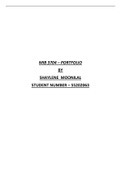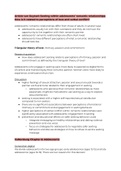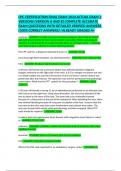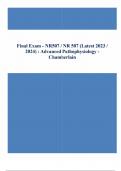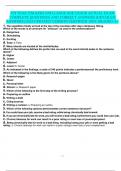Ch 14- The Parietal Lobe
I- Anatomy:
1. Subdivisions of the Parietal Cortex:
a. External demarcation of the Parietal cortex
- Between the frontal and occipital lobes
- Demarcated by the central sulcus/fissure
(anteriorly), the sylvian fissure (ventrally),
the parieto-occipital sulcus (posteriorly) and
the cingulate gyrus (dorsally)
Cingulate
Gyrus
b. Regions of the Parietal Lobe
The parietal Lobe can be divided into two functional zones:
- The Anterior Zone (3,1,2 and 43- Post central Gyrus) = The somatosensory Cortex
- The Inferior Zone (39 and 40 and 5,7- The supramarginal and angular gyri) = Posterior
Parietal Cortex
The parietal Lobe is composed of:
● Postcentral gyrus (Broadman’s areas 3,1,2)
● Superior Parietal Lobule (5,7)
● Parietal Operculum (43)
● Inferior Parietal lobe: Supramarginal Gyrus
(40) and Angular Gyrus (39)
There are two ways of classifying the Parietal regions:
● Based on Broadman’s areas
● Based on von Economo’s areas
, ○PE (parietal area E, equival. 5 and part of 7) = tactile recognition,
guiding movement by providing limb position
○ PF( parietal area F equival. 43, 40 and part of 7)= guiding movement
○ PG (parietal Area G equival. 40 and 39)= Posterior Parietal Cortex
=Crossroad that controls spatially guided behaviors with respect to visual and
tactile information
❖ PG is primarily visual and contains areas:
➔ Humans have known expansion of the inferior part of the PL
➔ Based on Broadman’s monkeys and humans are different because monkeys don’t
possess areas 39 and 40.
➔ Based on von Economo, PE, PF and PG are found in both monkeys and humans. The
difference is that humans have a larger size of PG and STS (superior temporal sulcus) in
terms of polymodal cells(receives input from more than one sense)
◆ Lesions either on the right or the left of the PL → different symptoms
from monkeys
➔ PG area is asymmetrical with a larger right part
➔ PG receives from somatosensory cortex and visual while STS receives from visual,
auditory and somatosensory.
2. Connections of the Parietal Cortex:
Understanding the Areas:
, Pathways:
1. Primary Somatosensory cortex (3,2,1) sends to PE
(tactile recognition) and 4,6 and SMA → provide
sensory info about limb position
2. PE receives from 3,2,1 and sends to 4,6,8, SMA and PF
→ Guide movement by providing info about limb position
3. PF receives from 3,2,1 through PE, 6, 4 and PG and sends
to 4, SMA, 6,8, and 46 → same function as PE
4. PG receives more-complex connections including visual,
somesthetic (skin sensations), proprioceptive (internal
stimuli), auditory, vestibular (balance), oculomotor (eye
movement), and cingulate (motivational?). Sends to 46,
temporal lobe and occipital lobe
➔ parieto-temporo-occipital crossroad
➔ Part of the dorsal stream +connection to the frontal
lobe = controls spatially guided behavior with
respect to visual and tactile information
The Dorsal Stream: 3 pathways
1. Parieto-premotor pathway= “how”
pathway
2. Parieto-prefrontal pathway=
visuospatial functions related to
visuospatial working memory
3. Parieto-temporal pathway →flows
to the hippocampus and
parahippocampal regions= role
in spatial navigation →
participating in non-conscious
visuospatial behavior → reaching
for and grasping objects
3. Theory of Parietal Lobe Function:
The two zones of the parietal lobe have specialized functions:
A. The anterior zone/Somatosensory → processing of somatic sensations and
perceptions
B. The posterior zone/Spatial →integration of sensory input from the somatic and
visual regions in order to control movement- reaching, grasping, whole body movement
in space). Plays a role in mental imagery (object orientation and navigation through
space)
➔ The parietal lobe plays a central role in creating a brain map of where things are
(through various series of neural representations of space)
, 4. Behavioral uses of spatial information:
1. Object Recognition: Coded in STS (superior temporal sulcus) and hippocampal
formation. Based on two systems of object’s relational properties:
○ Object-centered system: identifying object properties and characteristics
is important (color, shape, size and objective location) → to recognize
objects when seen in a different context or vantage point. Ex: the red
cup’s location relative to the green cup
○ Viewer-centered system: identifying object location, motion and local
orientation relative to the viewer. These computations are made
everytime we take action → to guide movement towards that object.
Details of object characteristics are not important
2. Movement Guidance:
○ The posterior parietal function projects to the frontal lobe motor structure for the
eye (area8, frontal eye fields) and to limbs (premotor and supplementary motor)
○ Connection to area 46 (prefrontal cortex) → role in short-term memory
for the location of events in space
○ Posterior parietal lobe → movement guidance. The single cells there
are active during sensory input, movement, and manipulation of object
by the viewer
i. Receives sensory, motivational, and related motor inputs
ii. Their discharge is enhanced when an animal attends to a target or moves
toward it
→ transforming sensory information into commands for directing attention and
guiding motor output.
○ Impairment in posterior parietal lobe→ impairment in movement
guidance
3. Sensorimotor Transformation:
○ Sensorimotor transformation: the neural calculations and constant update on the
location of the movements of various body parts (eyes, body, limbs) with sensory
feedback of what movements are actually being made (the efference copy) and
the plans to make the movements.
○ Posterior Parietal cortex→ produces movement-related and sensory-
related signals to make these calculations
○ PRR→ responsible for planning movement/desired goal of movement
for sensorimotor transformation → neuroprosthetic devices are made
based on this (moving paralyzed arms based on intention)
4. Spatial Navigation:
○ Route of knowledge: a mental list of what to do at each spatial location
→ the MPR (medial parietal region) specializes in this
○ The dorsal visual stream participates in route of knowledge → visually
guided movements are made at specific locations
I- Anatomy:
1. Subdivisions of the Parietal Cortex:
a. External demarcation of the Parietal cortex
- Between the frontal and occipital lobes
- Demarcated by the central sulcus/fissure
(anteriorly), the sylvian fissure (ventrally),
the parieto-occipital sulcus (posteriorly) and
the cingulate gyrus (dorsally)
Cingulate
Gyrus
b. Regions of the Parietal Lobe
The parietal Lobe can be divided into two functional zones:
- The Anterior Zone (3,1,2 and 43- Post central Gyrus) = The somatosensory Cortex
- The Inferior Zone (39 and 40 and 5,7- The supramarginal and angular gyri) = Posterior
Parietal Cortex
The parietal Lobe is composed of:
● Postcentral gyrus (Broadman’s areas 3,1,2)
● Superior Parietal Lobule (5,7)
● Parietal Operculum (43)
● Inferior Parietal lobe: Supramarginal Gyrus
(40) and Angular Gyrus (39)
There are two ways of classifying the Parietal regions:
● Based on Broadman’s areas
● Based on von Economo’s areas
, ○PE (parietal area E, equival. 5 and part of 7) = tactile recognition,
guiding movement by providing limb position
○ PF( parietal area F equival. 43, 40 and part of 7)= guiding movement
○ PG (parietal Area G equival. 40 and 39)= Posterior Parietal Cortex
=Crossroad that controls spatially guided behaviors with respect to visual and
tactile information
❖ PG is primarily visual and contains areas:
➔ Humans have known expansion of the inferior part of the PL
➔ Based on Broadman’s monkeys and humans are different because monkeys don’t
possess areas 39 and 40.
➔ Based on von Economo, PE, PF and PG are found in both monkeys and humans. The
difference is that humans have a larger size of PG and STS (superior temporal sulcus) in
terms of polymodal cells(receives input from more than one sense)
◆ Lesions either on the right or the left of the PL → different symptoms
from monkeys
➔ PG area is asymmetrical with a larger right part
➔ PG receives from somatosensory cortex and visual while STS receives from visual,
auditory and somatosensory.
2. Connections of the Parietal Cortex:
Understanding the Areas:
, Pathways:
1. Primary Somatosensory cortex (3,2,1) sends to PE
(tactile recognition) and 4,6 and SMA → provide
sensory info about limb position
2. PE receives from 3,2,1 and sends to 4,6,8, SMA and PF
→ Guide movement by providing info about limb position
3. PF receives from 3,2,1 through PE, 6, 4 and PG and sends
to 4, SMA, 6,8, and 46 → same function as PE
4. PG receives more-complex connections including visual,
somesthetic (skin sensations), proprioceptive (internal
stimuli), auditory, vestibular (balance), oculomotor (eye
movement), and cingulate (motivational?). Sends to 46,
temporal lobe and occipital lobe
➔ parieto-temporo-occipital crossroad
➔ Part of the dorsal stream +connection to the frontal
lobe = controls spatially guided behavior with
respect to visual and tactile information
The Dorsal Stream: 3 pathways
1. Parieto-premotor pathway= “how”
pathway
2. Parieto-prefrontal pathway=
visuospatial functions related to
visuospatial working memory
3. Parieto-temporal pathway →flows
to the hippocampus and
parahippocampal regions= role
in spatial navigation →
participating in non-conscious
visuospatial behavior → reaching
for and grasping objects
3. Theory of Parietal Lobe Function:
The two zones of the parietal lobe have specialized functions:
A. The anterior zone/Somatosensory → processing of somatic sensations and
perceptions
B. The posterior zone/Spatial →integration of sensory input from the somatic and
visual regions in order to control movement- reaching, grasping, whole body movement
in space). Plays a role in mental imagery (object orientation and navigation through
space)
➔ The parietal lobe plays a central role in creating a brain map of where things are
(through various series of neural representations of space)
, 4. Behavioral uses of spatial information:
1. Object Recognition: Coded in STS (superior temporal sulcus) and hippocampal
formation. Based on two systems of object’s relational properties:
○ Object-centered system: identifying object properties and characteristics
is important (color, shape, size and objective location) → to recognize
objects when seen in a different context or vantage point. Ex: the red
cup’s location relative to the green cup
○ Viewer-centered system: identifying object location, motion and local
orientation relative to the viewer. These computations are made
everytime we take action → to guide movement towards that object.
Details of object characteristics are not important
2. Movement Guidance:
○ The posterior parietal function projects to the frontal lobe motor structure for the
eye (area8, frontal eye fields) and to limbs (premotor and supplementary motor)
○ Connection to area 46 (prefrontal cortex) → role in short-term memory
for the location of events in space
○ Posterior parietal lobe → movement guidance. The single cells there
are active during sensory input, movement, and manipulation of object
by the viewer
i. Receives sensory, motivational, and related motor inputs
ii. Their discharge is enhanced when an animal attends to a target or moves
toward it
→ transforming sensory information into commands for directing attention and
guiding motor output.
○ Impairment in posterior parietal lobe→ impairment in movement
guidance
3. Sensorimotor Transformation:
○ Sensorimotor transformation: the neural calculations and constant update on the
location of the movements of various body parts (eyes, body, limbs) with sensory
feedback of what movements are actually being made (the efference copy) and
the plans to make the movements.
○ Posterior Parietal cortex→ produces movement-related and sensory-
related signals to make these calculations
○ PRR→ responsible for planning movement/desired goal of movement
for sensorimotor transformation → neuroprosthetic devices are made
based on this (moving paralyzed arms based on intention)
4. Spatial Navigation:
○ Route of knowledge: a mental list of what to do at each spatial location
→ the MPR (medial parietal region) specializes in this
○ The dorsal visual stream participates in route of knowledge → visually
guided movements are made at specific locations

